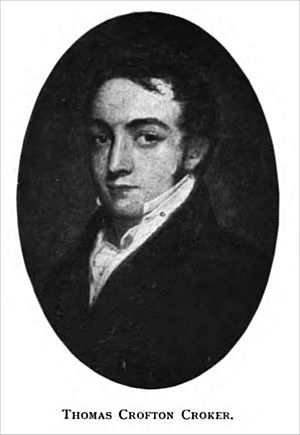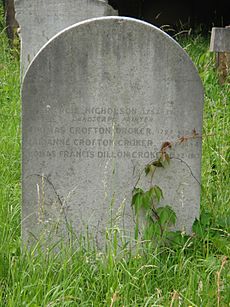Thomas Crofton Croker facts for kids

Thomas Crofton Croker (born January 15, 1798 – died August 8, 1854) was an Irish expert in old things and traditions. He is most famous for his book Fairy Legends and Traditions of the South of Ireland, published between 1825 and 1828. He was also very interested in Irish songs and music.
His book Fairy Legends was supposed to be a collection of stories he found during his trips. However, he lost his original notes. So, he had to recreate the book with help from his friends. Some people felt he didn't give enough credit to his helpers. One person, Thomas Keightley, even published his own similar book.
The famous writer William Butler Yeats used some of Croker's stories in his own collection. Yeats thought Croker sometimes made Irish traditions seem too funny. Other Irish critics agreed with this idea.
Contents
Life and Early Works
Thomas Crofton Croker was born in Cork, Ireland. He was the only son of Major Thomas Croker. When he was 15, he started learning about business. From 1812 to 1815, he traveled around southern Ireland. During these trips, he started collecting old legends and songs.
In 1813, Croker wrote down an Irish coronach (a sad song sung at funerals, also called keening) from Cork. He translated it into English. This translation was printed in a newspaper called Morning Post in 1815. The poet George Crabbe noticed it in 1817.
Croker was also good at drawing. His artwork was shown in Cork in 1817. But he soon decided to focus more on writing. Around 1818, he sent about 40 old Irish songs and poems to the poet Thomas Moore. Moore used these in his own book, Irish Melodies.
After his father passed away in 1818, a relative helped Croker get a job. He became a clerk at the British Admiralty, which was a government office. He worked there for 30 years until he retired in 1850.
Croker was a short man, about 4 feet 10½ inches tall. The writer Sir Walter Scott described him as "Little as a dwarf, keen-eyed as a hawk." Scott also said Croker had a very friendly way about him. Croker spent much of his life collecting old Irish poetry and Irish folklore.
First Book: Researches in the South of Ireland
Croker's first book was called Researches in the South of Ireland. It came out in 1824. Other experts who studied old things liked it a lot. Croker said in the book that his future wife, Miss Nicholson, and her brother, Alfred Nicholson, drew the pictures for the book. They went with him on his trips to gather information.
His Most Famous Work: Fairy Legends
After Researches, Croker published Fairy Legends and Traditions of the South of Ireland. This book came out in parts from 1825 to 1828. It became very popular. Even Sir Walter Scott praised it in his letters and books.
The first part of Fairy Legends was published in 1825. It was even translated into German by the famous Brothers Grimm in 1826. The second and third parts came out in 1828. The third part included a long essay about fairies by the Brothers Grimm. It also had some Welsh fairy tales written by a woman whose name was not given.
The first version of Fairy Legends had pictures made from woodcuts. For the second version, a Cork artist named Daniel Maclise drew new pictures. The book was printed six times during the 1800s.
Fairy Legends helped many people learn about traditional Irish tales. People in English-speaking countries and even further away read it. However, Croker changed the stories a bit to fit his own style. Some people said he made them too literary and added too much humor.
Daniel O'Rourke on Stage
Croker turned one of his tales, "Daniel O'Rourke," into a Christmas play. It was called "Harlequin and the Eagle." The play was performed in 1826 at the Adelphi Theatre. Sir Walter Scott, who was a friend of the actor who owned the theater, really liked the play. Croker had thought about making it a play even before Scott suggested it. The play was later published as Daniel O'Rourke, or Rhymes of a Pantomime.
Later Books and Life
Croker's third book was Legends of the Lakes; or, Sayings and Doings at Killarney (1829). This book was not as successful as his Fairy Legends. It was written like a tour guide through the beautiful places in Killarney. It included legends told in the local way of speaking. He also wrote about the music of his friend, the Irish piper James Gandsey. This part is interesting for people who study bagpipe or uilleann pipe music.
In 1830, Croker married Marianne Nicholson. She was the daughter of the painter Francis Nicholson. They had one son, T. F. Dillon Croker.
Croker helped start two important groups: the Camden Society (in 1838) and the Percy Society (in 1840). These groups helped publish old writings.
In 1844, he edited a collection called The Keen of the South of Ireland. This book included the keen he had collected in Cork in 1813. This was the same keen that caught the attention of poet George Crabbe earlier.
Croker and his wife wrote down important details about funeral customs. They especially focused on the tradition of keening (singing sad songs for the dead). Their writings are some of the earliest and most important information about Irish laments and their traditions.
Thomas Crofton Croker passed away in Old Brompton, London, England, on August 8, 1854. He is buried in Brompton Cemetery. His wife, Marianne, died shortly after him, on October 6, 1854.
List of Works
Croker's son said that two books, Barney Mahoney (1832) and My Village versus our Village (1833), were actually written by Croker's wife, Marianne.
- Researches in the South of Ireland (1824)
- Fairy Legends and Traditions of the South of Ireland, 3 volumes (1825–28)
- Daniel O'Rourke, 2nd edition (1828)
- Legends of the Lakes, or Sayings and Doings at Killarney (1829)
- Popular Songs of Ireland (1839)
- The Keen of the South of Ireland (1844)
- Popular Songs, Illustrative of the French Invasions of Ireland, Parts I–IV. (1845–1847), reprinted (1847)
Croker's son also listed more titles and journals he wrote for.




